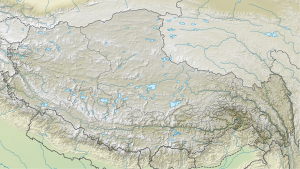Liushi Shan
| Liushi Shan | ||
|---|---|---|
| height | 7167 m | |
| location | Xinjiang , Tibet ( PR China ) | |
| Mountains | Kunlun | |
| Dominance | 289.38 km → Saser Kangri II | |
| Notch height | 1946 m ↓ ( 5221 m ) | |
| Coordinates | 35 ° 18 '52 " N , 80 ° 55' 1" E | |
|
|
||
| First ascent | August 16, 1986 by a Japanese expedition | |
The Liushi Shan is the highest mountain in the Kunlun mountain range on the border of the autonomous regions of Xinjiang and Tibet . Other names for the mountain are: Aksai Chin I , Liushi Feng , Kunlun I or Kunlun Goddess .
The Liushi Shan is located in the western section of the Kunlun. The glaciated mountain has a height of 7167 m . The east and west flanks of the Liushi Shan are drained south to the no-drain Lake Aksai Chin . North of the Liushi Shan lies the catchment area of the Yurungkax , a tributary of the Tarim .
Despite its nominally stately height of over 7000 m, the Liushi Shan is a comparatively inconspicuous mountain, which is due to the fact that the surrounding peaks reach heights of more than 6500 m and the valleys in between are at over 6000 m.
Liushi Shan II
The 6,930 m high secondary peak Liushi Shan II ( ⊙ ) is located 1.33 km north of the main peak. The notch height is 130 m.
Liushi Shan III
From Liushi Shan II a 1.43 km long mountain ridge leads east to the 6875 m high Liushi Shan III ( ⊙ ). The notch height is 175 m.
Ascent history
The Liushi Shan was first climbed on August 16, 1986 by a Japanese expedition over the east ridge from the south. The first group to climb consisted of Shinji Kobayashi, Shuya Nakashima, Tetsuya Baba, Yukimasa Numano and Masanori Sato. The following day, Kunio Obata, Takeshi Murata, Yukiko Kukuzawa, Mitsuhiro Sugawara, Shigeru Masuyama and Keijiro Hayasaka reached the summit.
Web links
- Liushi Shan, China on Peakbagger.com (English)
- summitpost.org
Individual evidence
- ↑ Liushi Shan II, China on Peakbagger.com (English)
- ↑ Liushi Shan III, China on Peakbagger.com (English)
- ^ A b Asia, China, P 7167, Kunlun Mountains . AAJ, 1987, vol. 29
